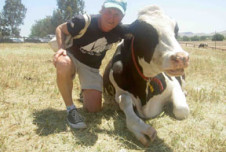Sharon Begley wrote a fascinating story for Newsweek last week about recent discoveries in the science of human evolution. She explains how technological advances are giving researchers a more precise understanding of when, how, and why humans diverged from the evolutionary path of other species.
It seems that what truly set humans from other species may have been changes in the architecture of their brains, which made them more skilled at reasoning, learning, and memory. Begley considers this finding along with the fact that humans five to six million years ago were small and had teeth suitable for fruits and nuts, but not meat. These facts, Begley writes, suggest "that early humans were more often prey than predators," an argument made by Washington University anthropologist Robert Sussman. And this conclusion has some profound implications for our understanding of human nature.
The realization that early humans were the hunted and not hunters has upended traditional ideas about what it takes for a species to thrive. For decades the reigning view had been that hunting prowess and the ability to vanquish competitors was the key to our ancestors' evolutionary success (an idea fostered, critics now say, by the male domination of anthropology during most of the 20th century). But prey species do not owe their survival to anything of the sort, argues Sussman. Instead, they rely on their wits and, especially, social skills to survive. Being hunted brought evolutionary pressure on our ancestors to cooperate and live in cohesive groups. That, more than aggression and warfare, is our evolutionary legacy.
Both genetics and paleoneurology back that up. A hormone called oxytocin, best-known for inducing labor and lactation in women, also operates in the brain (of both sexes). There, it promotes trust during interactions with other people, and thus the cooperative behavior that lets groups of people live together for the common good. By comparing the chimp genome with the human, scientists infer that oxytocin existed in the ancestor of both. But it has undergone changes since then, perhaps in how strongly the brain responds to it and in how much is produced. The research is still underway, but one possibility is that the changes occurred around the time our ancestors settled into a system based on enduring bonds between men and women, about 1.7 million years ago.





Comments